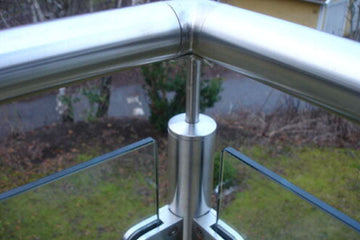
Glass clamps, rather than a simple box-ticking venture, are the key to a railing that appears to be beautiful and straight, and to one that bends, squeaks or misses compliance. When you are thinking about a balustrade, staircase, balcony, or deck having the glass infill, the clamp you select will determine how well the panels will fit together, how safe the system feels, and how long it will last outdoors. This tutorial will step you through the basics to enable you to be specific enough and save the cost of having to re-do it.
Glass clamps (also known as glass panel clamps or glass brackets) are the relatively small yet very important fittings that hold the edge of a glass panel firmly clamped to a post, wall, or base profile. In framed or post-and-clamp railings they provide regular spacing, hold panels straight and distribute loads to the structure. In semi-frameless installations they become the centre of the performance- fewest hardware, largest view.
In the distance, the clamps are not dissimilar. Even minor variations in body shape, type of gasket, locking mechanism, and finish are important in determining the speed of installation and longterm performance. Quality Glass Fittings (QGF) is specifically targeted at these particulars; solid cast bodies, uniform finishing, and interchangeable gaskets, to ensure that installers can work fast and with peace of mind.
Why Choosing the Right Glass Clamp Matters
1) Safety: Safety-critical are railings. Improper clamp, improper glass thickness, or improper fixation may compromise the line load resistance, and may affect safety.
2) Alignment and aesthetics: A good clamp will keep glass straight, will not creep, and will maintain a constant gap. The bad tolerances appear when the sightlines are wavy and as rattles.
3) Speed of install: At the location, the right clamp saves hours: easy-to-assemble, single-range glass thickness, and gaskets which really work.
4) Durability: Outdoors fences breathe rain, salt and UV. The hardware is held in place with high-grade stainless and well-sealed to keep the hardware looking fresh and eliminate undercover corroding.
5) Compliance: Spec-grade clamps are made to clamp tough, laminated glass and assist you to achieve regional building code requirements in combination with the proper glass and clamps.
Types of Glass Clamps
Although manufacturers will provide dozens of forms, the most common are:
1) Square/Rectangular Clamp
The traditional design on posts and wall returns. Flat faces help align panels. Reduced in black with square back plates or radius back plates to suit square posts or round tubes.
Best use: Post and clamp balustrades, stairs, mezzanines.
2) D-Shaped (Radius) Clamp
A smoother and rounded front and a small footprint. Frequently selected when you desire a less industrial appearance or you are cutting narrow centrelines in narrow posts.

Best use: Residential balconies, on the inside where a softer profile is more in keeping with the decor.
3) Heavy-Duty Deep Clamp
Greater height and lower jaw of thicker glass (usually 1221.5 mm laminated) and greater loads. With more clamping area, less slip is experienced and line load performance is enhanced.
Ideally installed on: Commercial buildings, terraces exposed to the wind, stadiums.
4) Adjustable/Slotted Clamp
Has a slotted plate on the back or a removable stand-off to allow a bit of play - useful when walls are not quite straight or when you are setting up gaps.
Best usage: Retrofits, and imperfect substrates.
5) Stand-Off Button Clamp (Point Fixing)
Another type: round pucks which are passed through the glass. They provide extremely clean, post less, floating glass appearance.
Better suited: Minimalist internal screens and feature stair balustrades (should have appropriate structure and glass).
6) Channel Mounted on base with Clamp Inserts.
A pair of shoes that have glass on the bottom; the panel is glued up by clamping inserts or wedges. Not a conventional clamp, but especially at posts, used together with small stabilising clamps.
Best when: You need it to be frame-free on the floor up to the ceiling and you want to have a frame-free appearance.
Helpful hint: in the QGF site, one would find clamps with range of glass thickness (8mm-10mm, 10mm-12mm, 12mm-21.5mm laminated) and back shape (flat/radius) to ensure that you match the post type and panel spec at the beginning.
If you want to know the secret behind strong and stylish glass doors, don’t miss our article on Patch Fittings for Glass Doors.
Factors to Consider Before Buying a Glass Clamp
Having the spec correct on paper is half the battle. Work through this checklist:

Glass Type and Thickness
- Interior railings are often made of toughened (tempered) glass.
- Laminated toughened just two (or more) panes with an inter-pane, which might be needed on the balcony to hold fragments in case a pane breaks.
- Match: Select your set of gasket caulking blocks to match your thickness of glass. The wrong gaskets will result in slip or crush.
Load Requirements
Codes are line loads (uniform loads at the height of handrail) and impact loads. The numbers are given in your engineer, or local standards; the clamp and post system has to be designed to fit them, when used with the given glass.
Substrate and Fixing Method
Fixing to what--steel post, timber, concrete or a wall return? Ensure:
1) Back plate shape is identical to that of post (SHS is flat, circular tube is radiused).
2) Screws /bolts are substrate rated.
There is sufficient edge distance to avoid masonry breakout.
Discover the Top-Selling Glass Balustrade Fixing Products
Environment (Interior vs. Exterior)
- Interior dry areas: 304 stainless is usually fine.
- Outside, coastal, poolside: Increase to 316 stainless and think about mirror / electropolished finishes to provide extra resistance to corrosion.
- Request EPDM or chloroprene gaskets; they do not wear out or discolour like inexpensive rubber..
Edge Conditions and Tolerances
Ensure that the clamp has some type of adjustment to the actual site conditions. Trick staircases can be turned into easy installed ones with fine slotted holes, shims or adjustable inserts.
Aesthetic Goals
Would you like the clamps to be non-conspicuous or conspicuous? Square has the contemporary, architectural appearance; D-shape is softer. Fingerprints are concealed by brushed (satin) finishes, pops are polished in the light.
Budget and Lifecycle Cost
Inexpensive clamps will do at first, but pitted finishes, slipping gaskets and screws that are frozen are more expensive in the future. A mid to high-end spec normally takes over the life of the building.
Safety and Compliance Standards
All railings will be safety systems. The following points should be kept in mind:
- Use rated glass. Use their directions of the glass manufacturer concerning edge distances and locations of holes (where point fixings are required). Avoid drilling on site.
- Mind the edge cover. Clamps are based on compression by gasket with a large area of compression on the edge of the glass. Do not use a too small clamp on thick panels.
- Anti-slip liners. Even pressure is distributed in quality gaskets. In case you notice the glass creeping once installed re-examine gasket selection and clamping load.
- Through-bolting versus set screws. To use on exterior or high load areas, select clamps with locking mechanisms and, when necessary, safety pin.
- Corrosion control. Water + salt + unrelated metals = bother. Use only stainless fixing, isolate where possible on carbon steel and seal penetrations.
- Local codes. UK readers use BS 6180 where a barrier is needed; these other areas have similar. Glass build up and fixing of occupancy and exposure category should be verified by your engineer..
Design and Finish Options
- Satin (brushed) stainless: A workhorse: Modern, hides wear, easy to maintain.
- Polished stainless (mirror): expensive appearance, required more often, hotels or show houses.
- Black (PVD or powder-coated): Darker frames are in-trend, but find strong coatings that can be used outside.
- Bronze/Graphite/Specialty: Finishes Sometimes, designer work requires custom finishes- request batch consistency.

Back Plates and Adaptors
Numerous clamps are supplied with flat and radius back plates as well. When mixing post type, make sure that you have the correct plate in each run.
Gasket Kits
A good supplier has sets of gaskets of usual thicknesses (e.g., 8, 10, 12, 12.76, 13.52, 17.52, 21.52 mm). Ready-made gaskets, which have labels on them, eliminate guessing onsite.
Common Mistakes to Avoid
- Placing order of clamps without verification of glass build-up. Take the glass first: then take the clamp s and gaskets to suit it--not to another.
- Mixing metals. Galvanic corrosion may occur in galvanised posts + stainless clamps unless they are isolated. Wear nice sleeves/washers and matching laces.
- Over-tightening set screws. One would like to squeeze a sliding panel. Install appropriate gasket and snug within the direction of the manufacturer.
- Ignoring drainage. Water will also creep behind fittings in external stairs and balconies. Seal-up and do not form traps where rubbish gathers.
- Skipping a mock-up. Dry-fit one bay on the floor. Check gaps, compression of gasket, and general appearance prior to engaging in the entire run.
- Omission of specification of finish on coastal sites. Where the air has salt, then use 316 stainless or higher. It will be self-recovering in prevented staining and replacements.
Installation Tips for a Smoother Day on Site
- Mark centre lines and glass edges with a removable pencil; a simple jig speeds repetitive post spacing.
- Shim posts true before you hang any glass—straight posts equal straight sightlines.
- Handle glass with clean gloves and stand panels on rubber blocks to protect edges.
- Tighten in stages. Get every panel roughly placed, then return to finalise gaps and torque across the whole run.
- Finish with a protective clean, removing construction residue and applying a light stainless cleaner to the clamps.
Why Buy Glass Clamps from Quality Glass Fittings?
Quality Glass Fittings is a UK-based expert in the area of hardware, which installers actually believe in. This is what you can see when you are acquiring clamps and other railing components in their assortment:
- Materials of specification quality. Clamps are made of high-quality stainless with clean cast and sharp machining, therefore, threads go smoothly and covers fit well.
- Thoughtful kit options. There will be clear glass thickness ranges and gasket sets which are expected to match reducing improvisation on the site.
- Finish consistency. Clamps, hinges and handrail brackets are all satin-finished and polished- your entire run together appears to be one piece.
- Breadth of choice. You will find a variety of compact D-shapes to fit inside and outside projects as needed by using smaller shapes to fit in residential stair cases, and heavy-duty clamps to fit in laminated glass balconies.
- Support and availability. The inventory in stock and prompt advice is time saving where schedules are critical.
When you are also choosing complementary parts, QGF catalogue usually includes handrail brackets, end caps, base shoes, stand-offs and spider fittings, meaning that you can have the look and metal grade unbroken all the way along.

Quick Selection Guide
- Internal stair balustrade, 8–10 mm toughened, square posts: Standard square or D-shaped clamps in satin 304 stainless with matching gaskets.
- Apartment balcony, 13.52–17.52 mm laminated, wind-exposed: Heavy-duty deep clamps in 316 stainless, security pins, and compliance-checked fixings.
- Coastal terrace with black frames: 316 stainless clamps with durable black coating (ask about PVD), plus stainless fasteners to match.
- Minimalist feature screen: Consider stand-off point fixings (with engineer input) or a base shoe system if you want truly frameless lines.
Maintenance: Keeping It Looking New
- Wash stainless and glass with mild soap and water; avoid harsh chlorides.
- Inspect annually for loose covers, torn gaskets, or staining—address early.
- Reapply protective cleaners to stainless in coastal regions; a few minutes every quarter can prevent tea-staining.
Conclusion
The right glass clamp is a small choice with big consequences. Match the clamp to your glass thickness, environment, and load requirements; insist on quality gaskets and corrosion-resistant finishes; and work with a supplier that understands the realities of site work. Do that, and your railing will look straight, feel solid, and stay that way for years.
If you’re ready to specify, explore the clamp styles, finishes, and gasket kits from Quality Glass Fittings—built for clarity, built to last.

